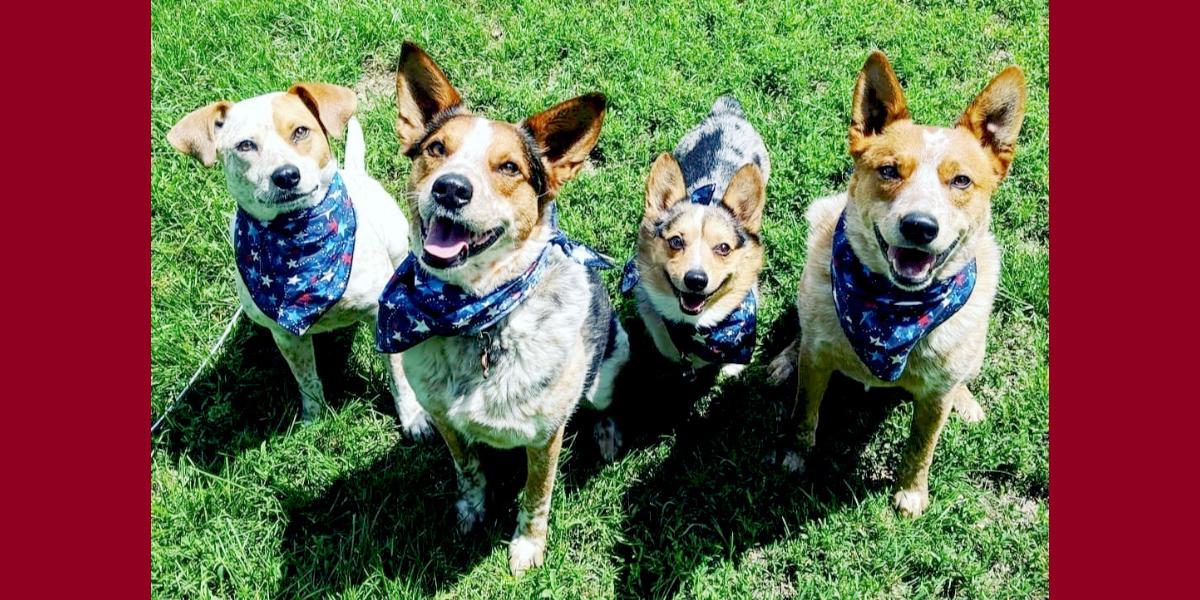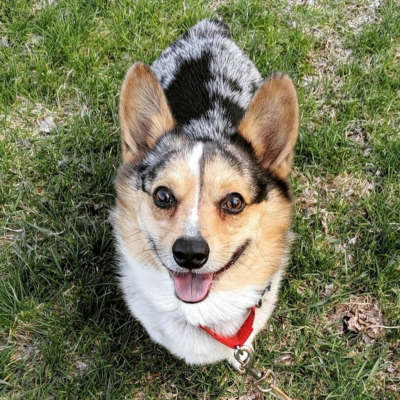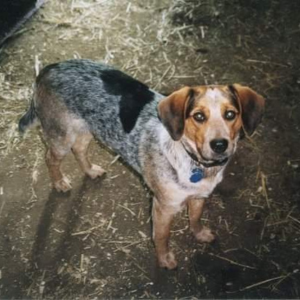Always there to help
Longtime VMC client recalls years of compassionate care and specialty services that have saved her animals time and time again

Longtime VMC client recalls years of compassionate care and specialty services that have saved her animals time and time again
(Left to right) Paisley, Taylor, Garth, and Ranger all received care from the Veterinary Medical Center at various points in their lives.
Animal lover Karyl Hylle currently cares for nine dogs—she prefers not to admit how many are pets and how many are fosters. In addition to dogs, she also cares for 20 Morgan horses and 20 Hereford beef cattle. Naturally, keeping her animals healthy requires access to quality veterinary care.
When her pets require care beyond the ordinary, she turns to the University of Minnesota (U of M) Veterinary Medical Center (VMC). Over the years, approximately 20 of her animals have been patients at the University.
The care her animals have received spans a spectrum of health conditions that have required expertise from across medical specialties, but there is one string that ties them together—Hylle’s trust in the VMC to help her animals in their time of need.
Hylle shared a few of the most impactful stories of her animals and their experiences at the VMC.
Garth is a 19-pound corgi with a personality larger than life. In July 2023, Karyl noticed bright red blood in Garth’s stool. With nothing else seeming amiss, Hylle wondered if Garth had consumed too many apples scattered in the yard. Worsening symptoms and several visits to the vet yielded no improvement.
Desperate to help her four-legged friend, Hylle turned to the expert care at the VMC. Garth underwent a series of exams, blood tests, and diagnostic testing—including a colonoscopy, endoscopy, a CT scan, and a tissue biopsy—over several weeks.

Based on visual findings and lab work, clinicians diagnosed Garth with protein-losing enteropathy (PLE), irritable bowel disease (IBD), and lymphangiectasia. PLE causes the loss of proteins from the bloodstream into the gastrointestinal tract and results from any one of several underlying causes affecting the body's lymphatic or digestive systems. Garth’s condition likely stemmed from IBD and dilation of the lymph vessels in his intestine.
Garth’s refusal to eat food prescribed to help his condition led to an appointment with Dr. Julie Churchill, head of the VMC Nutrition Service. Churchill and her team closely monitored Garth, trying a specialized diet coupled with various treatments. While they searched for the right combination of diet and therapies, Garth continued to drop weight.
“I was in tears every day,” Hylle says. “He was losing weight very rapidly, and I was certain I was going lose him. He was very sick, deteriorating rapidly, and his quality of life was very poor.”
Finally, a solution was in sight. Dr. Molly Doyle and the Small Animal Internal Medicine team added one more medication to Garth’s treatment. His IBD responded to the medicine, and his inflammatory symptoms resolved. Hylle describes Garth’s turnaround as magical.
“His appetite returned, and he would eat anything put before him,” she says. “He even enjoyed the prescription food he had previously refused to eat.”
Garth regained his energy and a healthy weight, and his labs soon showed remission of the PLE. He recently celebrated his 8th birthday.
Throughout her interactions with Garth’s care team, Hylle says they were compassionate, driven, innovative, and informative. They always listened carefully to her concerns and quickly answered her questions.
In 1997, Hylle’s Morgan mare, Apryl, entered the doors of the large animal hospital. In preparing Apryl for the upcoming show season, the trainer found her unable to bear weight on one leg. Recognizing the seriousness of the situation, the trainers loaded Apryl on the trailer and drove her to the U of M.

X-rays revealed the mare had a catastrophic injury to her left front pastern just above the hoof. She was diagnosed with a very severe, comminuted fracture that involved all three of her pastern joints, and her prognosis was very poor. After a lengthy discussion, Hylle and the veterinary team agreed to attempt to save the mare’s life.
Surgeons inserted pins through Apryl’s cannon bone to take some of the weight off of her pastern joint while it healed in a cast. She lived at the hospital for a couple of months, undergoing multiple procedures and cast changes. Apryl exceeded everyone’s expectations and was discharged from the hospital.
Apryl lived comfortably for 13 more years, going on to have five foals—all sharing her good nature, talent, and beauty. Describing Apryl’s success as genuinely amazing, Hylle feels the equine veterinary team performed a miracle on a horse that statistically shouldn’t have survived.

Hylle brought her first dog, Ocho, to the VMC for care back in 2002. She had adopted Ocho shortly after she moved out of her parents' house to attend college. The dog escaped out the door on Thanksgiving weekend and was hit by a car. Hylle rushed Ocho to the U of M, where she knew he would receive the best care possible. The Emergency and Critical Care team determined Ocho had sustained a broken back in the accident. A surgery performed by the Neurology team resulted in Ocho recovering and living to 14 years old with no lingering problems.
The Emergency and Neurology teams at the VMC came to Hylle’s aid again in 2023 to save her dog, Caleb. Extremely fearful, reactive, and poorly socialized, Caleb was one of 200 dogs rescued from a horrific dog hoarding case in Tennessee.

Caleb has epilepsy and possibly some type of movement or muscle disorder. During one episode, he had a seizure that warranted an emergency room visit. By the time they reached the clinic, he had been seizing for more than 30 minutes, and his body temperature had climbed to more than 106 degrees. At high risk of permanent brain damage or death, Caleb urgently needed to get his body temperature lowered and gain control of the seizures and tremors. The Emergency and Critical Care team successfully reduced his body temperature and stopped his tremors and seizures.
A regular at the VMC, Caleb requires special protocols during his visits due to his behavior and history of trauma. The veterinary team goes out of its way to create a positive experience for Caleb and uses medications to reduce his stress during appointments, according to Hylle. His medications control his epilepsy, and he currently remains seizure-free.
One of Hylle’s most endearing experiences at the VMC involved her soulmate, a dog named Ranger. Adopted as a puppy in 2017, Ranger seemed healthy and athletic. In 2020, he woke up one morning very lethargic, refusing to eat, and vomiting after drinking a small amount of water.
Hylle sensed the urgency of Ranger’s situation and quickly took him to the VMC. With COVID-19 restrictions at the time, Ranger was whisked away while Hylle remained in her car. In constant communication with her during the visit, the team informed Hylle that an irregular heart rate was the cause of Ranger’s problems.

Ranger had ventricular tachycardia, an irregular rhythm in which the lower heart chamber beats too fast to pump efficiently, preventing the body from receiving enough oxygenated blood. His care team returned Ranger’s heart to a normal rhythm and hospitalized him to perform further tests.
Ranger’s heart showed evidence of right-sided heart failure. Discharged with medication, he did well for about a year. At his next recheck, the heart failure signs had reversed, and he had a normal heart rhythm. A year later, Ranger’s symptoms recurred and he was taken to the emergency room.
While Ranger’s quality of life was excellent outside of his cardiac episodes, Hylle sought a long-term solution. Eventually, a specialist in Ohio contacted by then-VMC resident Dr. Keaton Morgan offered some hope with a procedure. Unfortunately, it did not fix his arrhythmia—the electrical signals of his heart were too complex and severe.
Ranger experienced another episode shortly after the procedure, and Hylle ended up having to say goodbye to the dog she loved more than anything. While devastated to lose her soulmate, she took comfort in knowing they had tried everything possible to help him.

Throughout Hylle’s experiences receiving care for her animals at the VMC, she felt grateful for the depth and breadth of expertise available.
She also appreciates the level of communication she received, whether via after-hour texts to update her on the status of her pet or from the care team as they explained a diagnosis and treatment options.
With over 20 pets cared for at the VMC, Hylle attests to the unsurpassed veterinary services available to animals large and small.
Whether for the routine care required to keep a pet healthy or for specialty care that may be outside of the expertise of a primary care general veterinarian, Hylle wholeheartedly recommends the services of the VMC.